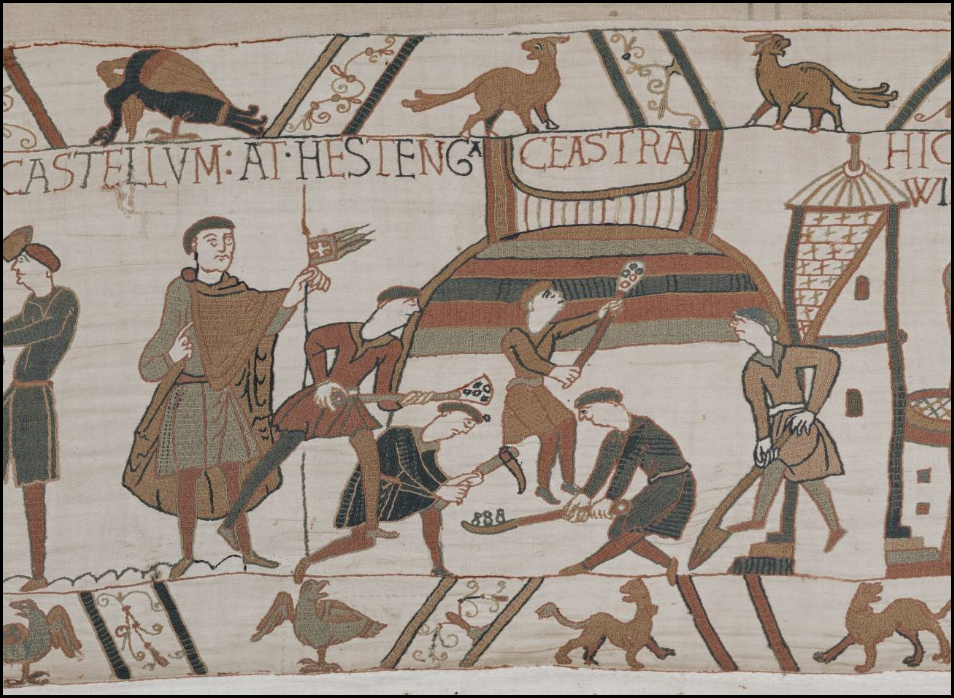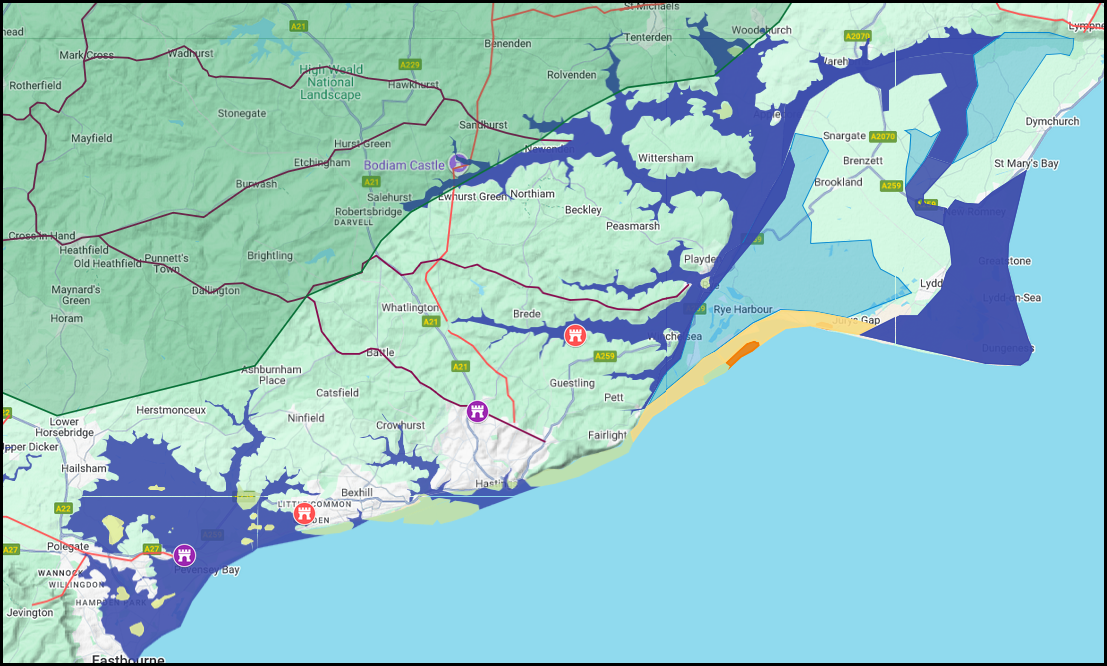|
 | Anglo Saxon History |  | |
| | Battle of Hastings 1066AD - M - The Castles |
|---|
| | Documentary evidence for the Castles ▲ |
|---|
Battle Abbey Chronicles
Things thus turning out according to his wishes, the duke did not long remain in that place, but went away with his men
to a port not far distant called Hastings ; and there, having secured an appropriate place, and acting upon a prudent
determination, he speedily built a castle of wood.
This implies a pre-fabricated fort
Bayeux Tapestry
(The Motte and Bailey is built and the troops go off and burn the villages.)
odo eps willelm rotbert
(Bishop Odo, William and Robert)
iste jussit ut foderetur castellum at Hastenga
(he ordered that a motte should be built at Hastings)
ceastre
(the camp)
hic nuntiatum est willelm de harold
(here William is told about Harold)
hic domus incenditur
(here a house is burned)
This implies a pre-fabricated fort as well
Carmen de Triumpho Normannico
You secure the bridgehead fearing to neglect the ships
And raise palisades, that you may site the camp within
You restore the forts that were long since destroyed
You station garrisons that they may be defended
Not much space has been occupied by your men in peace
This implies a pre-fabricated fort as well as restoring the 'forts' presumably Pevensey Castle
and Alfred the Great's Burh at Hastings
Henry of Huntingdon
Harold, king of England, returned to York the same day, with great triumph. But while he was at dinner, a messenger
arrived with the news that William, duke of Normandy, had landed on the south coast and had built a fort at Hastings.
This implies a pre-fabricated fort as well
Master Wace
The first day they held their course along the seashore ; and on the morrow came to a castle called Penevesel. The
squires and foragers, and those who looked out for booty, seized all the clothing and provisions they could find, lest
what had been brought by the ships should fail them ; and the English were to be seen fleeing before them, driving off
their cattle, and quitting their houses. All took shelter in the cemeteries, and even there they were in grievous alarm.
He saw the archers come forth from the ships, and the knights follow. He saw the carpenters with their axes, and the
host of people and troops. He saw the men throw the materials for the fort out of the ships. He saw them build up and
enclose the fort, and dig the fosse around it.
When they had reached the spot where the archers stood, and the knights were assembled, they consulted together, and
sought for a good spot to place a strong fort upon. Then they cast out of the ships the materials, and drew them to
land, all shaped framed and pierced to receive the pins which they had brought, cut and ready in large barrels ; so that
before evening had well set in, they had finished a fort.
The duke placed a guard in Hastings, from the best of his knights, so as to garrison the castle well, and went thence to
Romenel, to destroy it utterly, because some of his people had arrived there, I know not by what accident, and the false
and traitorous had killed them by felony.
This implies the occupation of Pevensey Castle, a pre-fabricated fort and presumably Alfred the
Great's Burh at Hastings
Orderic Vitalis
The Norman expedition, therefore, crossed the sea on the night of the third of the calends of October [29th September],
which the Catholic church observes as the feast of St. Michael the archangel, and, meeting with no resistance, and
landing safely on the coast of England, took possession of Pevensey and Hastings, the defence of which was entrusted to
a chosen body of soldiers, to cover a retreat and guard the fleet.
This implies the occupation of Pevensey Castle, and Alfred the Great's Burh at
Hastings
| | Summary of the Chronicles ▲ |
|---|
If we take all descriptions together then William must have taken Pevensey Castle, then built a pre-fabricated fort in
his sea side camp, and then finally occupied Alfred the Great's Burh at Hastings.
| | Pevensey Castle potted History ▲ |
|---|
Carausius, a Roman naval commander tasked with clearing the English Channel of Frankish and Saxon pirates, was accused
of corruption by the senior Roman Emperor Maximian. Facing execution, he revolted in 286 AD, declaring himself emperor.
At this time he controlled Britannia and Gaul, the Norther province in France.
Carausius controlled the Wealden Iron production, Roman fleet shipbuilding at Pevensey and the Classis Britannica (the
Roman Channel fleet), and appeared to be a very adept naval commander.
In 293 AD, when the Caesar Constantius Chlorus recaptured his Gallic holdings and besieged Gesoriacum (Bolougne - the
Classis Britannica main base), Carausius had already started to build a replacement but smaller, Fleet Headquarters at
Pevensey that was finished about 290AD and a second fort was constructed at Hythe to defend the iron exporting from the
Rother, Brede, Tillingham iron production areas.
Pevensey was completed about 290AD and is the largest Roman Shore fort in Britain covering about 3.7 hectares, and
nowadays it contains a Norman Castle similar to that at Bodiam but in less good repair.
Carausius was killed by his Accountant Allectus in 293AD - the moral of this story is 'never trust an
Accountant'. Obviously an Accountant wasn't a very good commander and was killed by Asclepiodotus in 296AD and
Britannia rejoined the Empire.
After the Romans left it was occupied by the Romano British until Aelle of Sussex took the castle in 491AD. It was
probably kept in a reasonable condition as its massive walls would have provided good protection for the locals.
In 772AD Sussex was taken by Mercia, and then in 796AD King Offa died and Sussex became independent again, but in about
725AD Wessex took over and it remained part of Wessex until 1066AD.
in the 11th century the Godwin family became controllers of West Sussex, so would have owned Pevensey, and its recorded
that Earl Godwin used it in various raids along the coast.
Duke William needed to control this fort as it was owned by the Godwins, and probably controlled
shipbuilding inland near Ashburnham.
| | The Hastings Burh of Alfred the Great ▲ |
|---|
The Burghal Hideage written in about 914AD lists the defensive forts around the Kingdom of Wessex used for protection
against the Vikings and their raids. One of the smaller ones is recorded for Hastings. For more details on the Hideage
please click the following link Anglo Saxon Chronicles -
914AD - Alfred the Great and the Burghal Hideage
The details are a bit skimpy, but please look to my page Landscape - Alfred the Greats fort in Hastings
for my suggestion as to its location and details.
The burhs were fortified sites established by Alfred the Great and his successors to defend against Viking raids, so
most are someway inland.
Their functions included:
- Providing refuge for the rural population within a 15–20 mile radius.
- Serving as strategic strongholds to control movement along roads and rivers.
- Acting as economic and administrative centers, with some housing mints for coinage.
Some scholars have claimed that the Hastings Burghal Hideage Fort was at Pevensey castle, however this is much too large
for the Hideage fort, and would also have been too close to the coast.
The Hastings Burh would have been the largest defensive position in the Hastings area, so again a
place that William needed to occupy.
|
Duke Williams Ikea flat pack fort ▲
|
|---|

This is an illustration from the Bayeux Tapestry that shows Williams engineers building the Motte and Bailey and putting
a wooden fort on top, please click on the image to see the online Bayeux tapestry.
A fort was constructed with a ditch and soil mounded behind the ditch.
Carmen de Triumpho Normannico
And raise palisades, that you may site the camp within
A palisaded(fort) was constructed
Henry of Huntingdon
and had built a fort at Hastings.
William builds a fort
Master Wace
He saw the men throw the materials for the fort out of the ships. He saw them build up and enclose the fort, and dig
the fosse around it.
When they had reached the spot where the archers stood, and the knights were assembled, they consulted together, and
sought for a good spot to place a strong fort upon. Then they cast out of the ships the materials, and drew them to
land, all shaped framed and pierced to receive the pins which they had brought, cut and ready in large barrels ; so that
before evening had well set in, they had finished a fort.
Master Wace gives very detailed and believable report of a kit type fort being built with a fosse and mound.
| | Where might the fort be ? ▲ |
|---|
Possible Fort location:- Medieval moated site, Cooden
'The moated(fosse) site at Cooden includes a nearly square moat with arms 50-60m long and 12-14m wide which
surrounds an island
30m square. Also included is a low earthen causeway at the centre of the north-eastern arm of the moat which
provided access to the
moat island. Historical records suggest that the moated site was the manor of the de Codyinge family, of local
prominence in the
13th and 14th centuries. A house stood on the moat island until the 19th century, but it is not known whether this
was an original
or later structure.'
please note this is a small quote from
https://historicengland.org.uk/listing/the-list/list-entry/1012918?section=official-list-entry
If this is the location, then the digging of the fosse and the movement of the excavated soil into the centre to
show a mott would give an ideal grounding for the wooden castle(which appears to have been shown in the Bayeux
tapestry).
This could be the original location of the fort as it was occupied in the 1200's, not that much later than the
Battle of Hastings.
The old fort site could easily have been modified to allow a Norman family to live in relative safety without any
additional work,
but at this moment there is no proof. However there do not seem to be any further locations anywhere nearby that
show any possibility
of being a fort with a moat/ditch.
Possible Fort location:- Medieval moated site, Snailham near Winchelsea.
This location is in the Brede valley and is protected as described in the Carmen, this possible fort is shown as
earthworks on
the OS maps. Currently I have no further details of this site.
Other locations
If you have any other sites where lidar can show a moated area near the coast please let me know via the 'Contact
Simon' link at the bottom of the page.
| 
From the left on the map we have Pevensey Castle in purple, then Cooden Moat in red, then the Hastings Burh at Baldslow
Down in purple and finally the moated site at Snailham in the Brede Valley in red.
| | Conclusion ▲ |
|---|
From all the Chronicle entries I will make the assumption that Pevensey Castle and Hastings Burh were
the restored castles.
The flatpack castle if it can be found is most likely to be at Cooden moat, as Snailham would involve a trip past New
Romney with the whole fleet, so any form of attack by the people of New Romney would have the town destroyed before the
battle took place and this is not described in the chronicles as william is supposed to have destroyed Romney after the
Battle.
|
|
|
|
|
|
| |
|
|
Local Interest
Just click an image |
|
|
|
|
|
|
|
|
|
|
|
|
| |
|
|